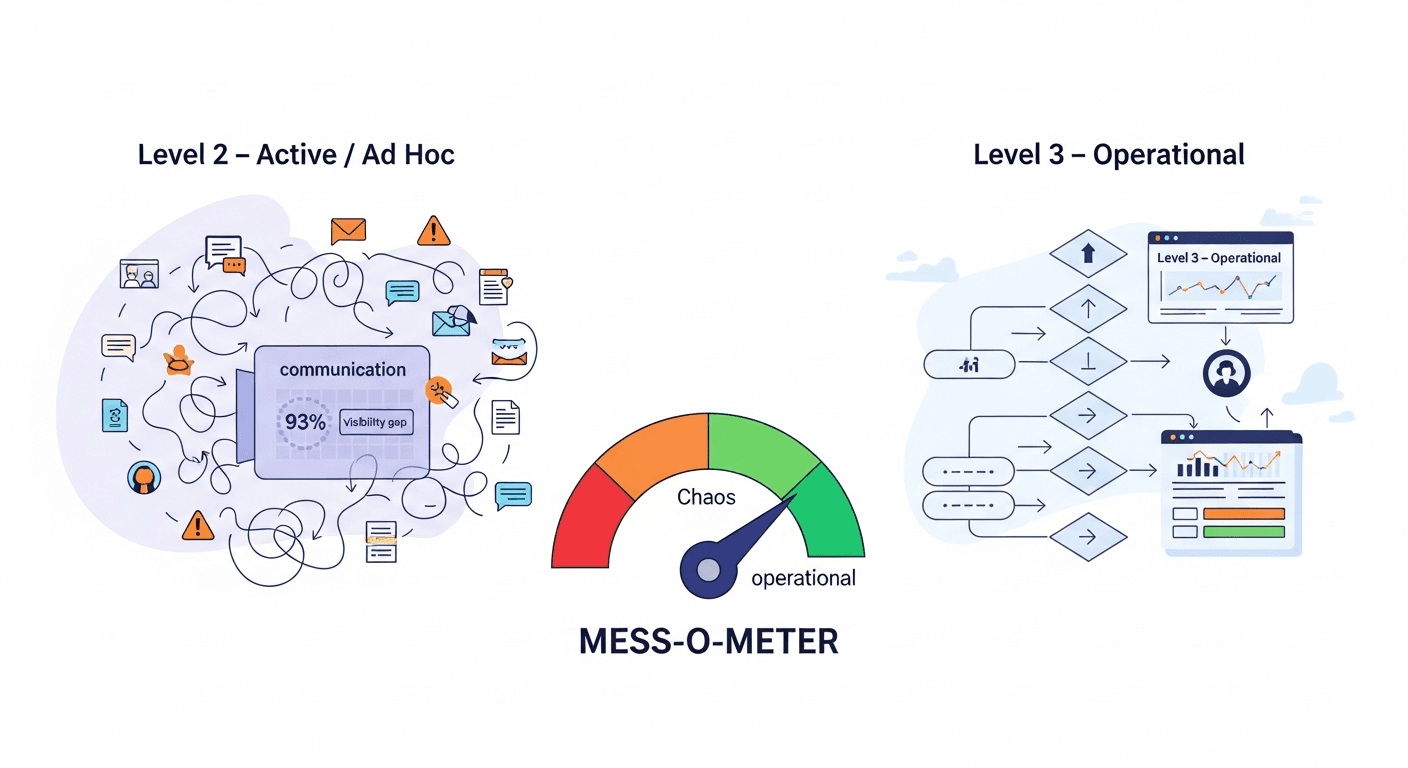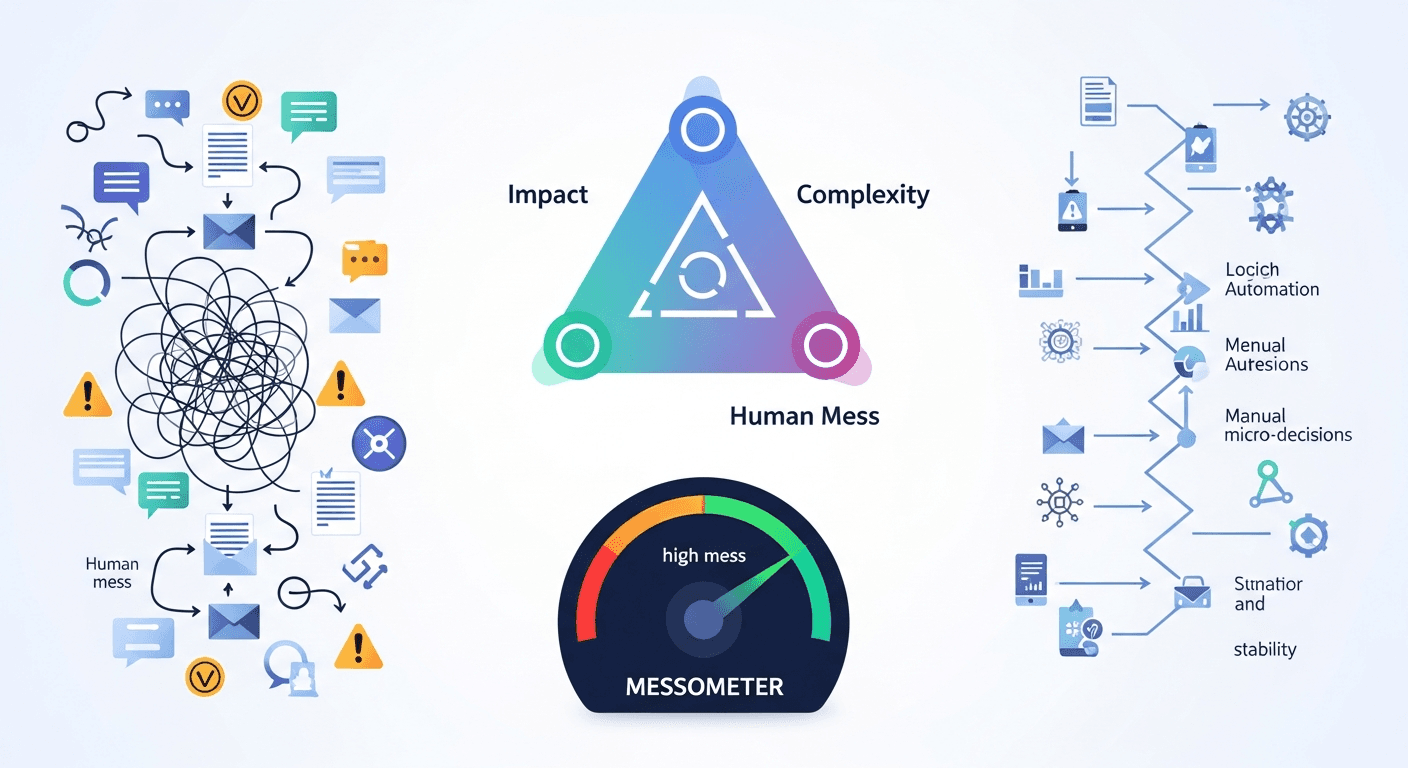Monday, 17 Nov 2025
|Escape Level 2 AI Maturity with the Mess-O-Meter

From Ad Hoc to Operational: Using the Mess-O-Meter to Escape Gartner’s Level 2 AI Maturity
Reaching true AI maturity requires more than experimentation—it requires operational discipline. Yet most organizations never progress past Gartner’s Level 2 “Active” stage, where AI experiments are plentiful but inconsistent, fragmented, and unsupported by defined processes.
The hidden culprit behind this stagnation is something most leaders never measure: Manual Micro-Decisions and chaotic, conversation-driven workflows. These are precisely the factors the messometer quantifies. And once leaders finally see the operational chaos that keeps them stuck, the path to Level 3 becomes clear, achievable, and measurable.
Understanding the Gartner Level 2 “Active” Stage
Organizations at Level 2 typically display enthusiasm for AI—and scattered efforts to adopt it. Teams run pilots, test tools, and build prototypes. But these efforts lack formal structure, shared standards, and consistent workflows.
Why Level 2 Is the Most Common Stalling Point
Most companies stay at Level 2 because:
- AI experiments are isolated
- Processes are undocumented
- Teams rely on knowledge in people’s heads
- Decision-making varies widely by individual
- Data inputs are inconsistent
These are symptoms of a deeper problem: the organization has no unified, reliable operational foundation for AI.
The Hidden Risks Behind Informal AI Experiments
Informal AI efforts appear innovative on the surface, but beneath the surface they create:
- Duplicate work
- Conflicting data handling patterns
- Unpredictable outputs
- Risk exposure
- Unmanageable exceptions
These inconsistencies create the perfect environment for repeated AI failure.
The Link Between Level 2 Stagnation and High Mess-O-Meter Scores
Every organization stuck at Level 2 shares one painful truth:
They have not standardized how work gets done.
Why Ad Hoc AI = High Manual Micro-Decision Counts
When workflows aren’t defined:
- Humans substitute rules with judgment
- Every task requires “figuring it out”
- Decisions can vary 30–70% by person
- AI has no stable baseline to learn from
The messometer detects and quantifies these micro-decisions so leaders can finally see what’s blocking maturity.
The Correlation Between Rework, Exceptions, and Chaotic Workflows
High messometer scores correlate strongly with:
- Frequent exceptions
- Repeated clarifications
- Unclear ownership
- Conflicting task interpretations
These forces all prevent an organization from advancing to Level 3, where defined, repeatable processes are the foundation.
What the messometer Measures (and Why It Matters)
The messometer exposes the hidden mechanics of how work really flows—not how leaders think it flows.
It measures three key drivers of operational chaos:
Manual Micro-Decisions
Tiny, repeated choices humans make to complete a task.
AI cannot perform reliably when these aren’t defined.
Conversational Bottlenecks
Where people rely on each other to clarify, interpret, or correct the work.
These create invisible delays that break automation flow.
Workflow Chaos Indicators
Signals that a process is inconsistent, unstable, or overly dependent on tribal knowledge.
The Reality of Informal AI Experimentation
Inside Level 2 organizations, work often depends on:
Shadow Processes
Unofficial workflows created by employees to compensate for unclear systems.
Tacit Knowledge Gaps
Information stored in people’s minds, not documented anywhere.
Invisible Decision Paths
Work gets done, but no one can explain how it really happens.
These are precisely the patterns the messometer makes visible.
Manual Micro-Decisions: The Silent Enemy of AI Maturity
The number one blocker to scalable AI is not data quality—it’s human inconsistency.
Identifying Hidden Cognitive Load
Employees make hundreds of decisions daily simply because the process doesn’t define them.
These decisions become failure points when AI tries to replicate the same task.
Why AI Fails Without Decision Standardization
AI works only when patterns are stable.
Micro-decisions introduce noise, and noise kills AI performance.
Chaotic Workflows and Their Operational Impact
Without standardization:
Disconnected Tasks
Teams don’t understand upstream or downstream dependencies.
Undefined Handoffs
Work gets lost or delayed during transitions.
Fragmented Communication Channels
Different teams use email, chat, tickets, and meetings without alignment.
This chaos creates Level 2 stagnation every time.
How the messometer Quantifies Chaos
The messometer transforms hidden process mess into measurable metrics.
Scoring Methodology Overview
Scores reflect conversational friction, decision inconsistency, and workflow unpredictability.
Determining Process Reliability
Low scores mean stable workflows.
High scores mean uncontrolled human variation.
Extracting Conversational Friction Patterns
This shows exactly where processes break—and why.
Using the messometer to Transition from Level 2 → Level 3
To advance to Level 3 AI maturity, an organization must achieve:
- Repeatability
- Predictability
- Defined workflows
- Documented decisions
The messometer provides the evidence and clarity required to build this foundation.
Creating Defined Processes
Leaders can see precisely which decisions must be standardized.
Establishing Repeatability
Work becomes consistent enough for AI to replicate.
Preparing for Standardized AI Deployment
AI becomes a force multiplier—not a chaos amplifier.
The 4 Signals an Organization Is Ready for Level 3
1. Reduced Manual Micro-Decisions
2. Documented Workflows
3. Predictable Exception Paths
4. Stable Data Inputs
These are measurable through messometer scoring.
Case Example: How a High Mess-O-Meter Score Revealed Why AI Was Failing
Before Measurement
A company attempted to automate onboarding.
AI failed repeatedly due to inconsistent human steps.
After Standardization
The messometer revealed 47 micro-decisions made by employees during onboarding.
Resulting AI Gains
Once standardized, AI success rates jumped from 23% to 88%.
Why Process Definition Must Come Before AI Scaling
AI cannot fix human chaos.
It magnifies it.
AI Cannot Fix Human Chaos
Broken processes in → broken AI out.
The Need for Operational Maturity
Level 3 requires clarity, not experimentation.
AI as a Force Multiplier, Not a Bandage
AI multiplies whatever it’s given—good or bad.
See your Mess-O-Meter in minutes.
FAQs About the messometer and AI Maturity Levels
1. Why do so many companies get stuck at Level 2?
Because they lack defined, repeatable workflows.
2. How does the messometer help?
It quantifies hidden human decision-making and workflow chaos.
3. What are Manual Micro-Decisions?
Small decisions employees make due to unclear processes.
4. Can AI succeed if micro-decisions are not standardized?
No—AI requires predictable patterns.
5. How long does a messometer assessment take?
Most organizations complete it in 1–2 weeks.
6. Where can I learn more about AI maturity frameworks?
Visit: https://hbr.org
Conclusion
Organizations cannot escape Level 2 without confronting their hidden workflow chaos.
The messometer exposes the Manual Micro-Decisions and Chaotic Workflows that block AI maturity.
Once leaders see the operational truth, the move to Level 3 becomes not only possible—but predictable.
All blog posts
View All →
Tuesday, 18 Nov 2025
AI Prioritization with the Mess-O-Meter Framework
Triangulate impact, complexity, and human mess with the messometer to prioritize AI projects scientifically and reduce failure risk.

Monday, 17 Nov 2025
Escape Level 2 AI Maturity with the Mess-O-Meter
Use the messometer to measure manual micro-decisions and chaotic workflows so you can move from ad hoc AI experiments to operational, scalable AI.

Saturday, 15 Nov 2025
The 93% Visibility Gap: Why the Mess-O-Meter Is Your Powerful First Step in the AI Maturity Journey
Discover how the messometer exposes the hidden “communication black box” in your workflows. Learn why diagnosing this 93% visibility gap is essential before any AI implementation to avoid failure.